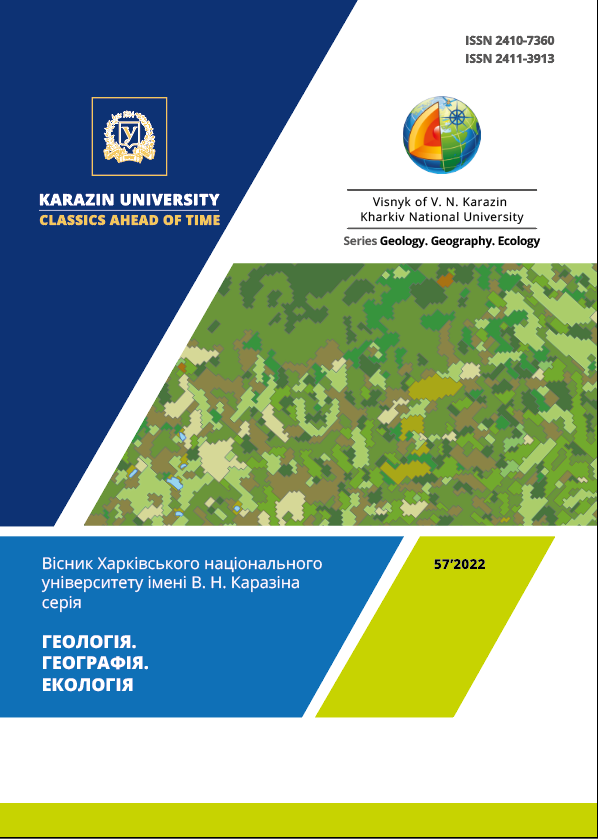Cultural landscape zoning of Ukraine
Abstract
Formulation of the problem. Nowadays in Ukraine there is a significant gap in the application of cultural-landscape approach and the lack of cultural and landscape zoning (CLZ) at different taxonomic levels, as one of the fundamental stages in the protection and preservation of cultural and natural heritage, which is recognized in a number of international documents by the world community.
The purpose of the article. The purpose of this study is to develop methodological approaches to CLZ in Ukraine.
Analysis of recent research and publications. The study and analysis of the experience of differentiation and zoning of different level territories on the basis of cultural and landscape approach in some European countries showed the crucial role of CLZ in studying cultural landscapes and planning management actions for their protection, conservation and use.
Methodology and results. The overall purpose of CLZ was to identify, define and differentiate integral natural and cultural systemic territorial formations of different levels, which form a set of interconnected cultural landscapes in a given area. The main factors of cultural-landscape differentiation of Ukraine at the macro level were natural-geographical, ethnographic, linguistic, historical-geographical, historical-political and administrative-territorial features and features of spatial localization and concentration of natural and cultural heritage - immovable and intangible. The information base for conducting the CLZ were researches that reflects the territorial differentiation of Ukraine by these groups of features and has developed appropriate zoning schemes with their cartographic implementation. The taxonomic system of the country's CLZ has been developed. It consists of two levels: 14 cultural-landscape regions and 52 cultural-landscape macro-districts; 26 cultural and landscape regions have been identified as a separate taxon, outside of the hierarchy, according to the administrative-territorial division of the country. The most important result of the study – the map "Cultural-landscape zoning of Ukraine", became one of the key topics of the electronic atlas "Population of Ukraine and its natural and cultural heritage". The development of the atlas was completed in 2020 by the Institute of Geography of NASU.
Scientific novelty and practical significance. For the first time in Ukraine, CLZ has been developed at the macro level, thus starting to fill a gap of the absence of domestic developments of this kind. The study identified proposals on the main directions of development and practical application of CLZ in the field of protection and preservation of cultural and natural heritage through inclusion in the systems of national and regional strategy, spatial development planning, research on integrated study of territory, mapping and development of CLZ regions and administrative districts, etc.
Downloads
References
Rudenko L., Bochkovska A., Polyvach K. (2021). Academic geography and atlas mapping during the years of Ukraine's independence. Kyiv: Institute of geography of NASU, 120. [in Ukrainian]
Institutions of culture, physical culture, and sports of Ukraine in 2016. (2017). Statistical Bulletin. State Statistics Service of Ukraine. Kyiv, 89. [in Ukrainian]
Ehrlich, M. et al. (2020) Typology of Historical Cultural Landscape of the Czech Republic. České Budějovice: Národní památkový ústav, 170. [in Czech]
Husovská, Ľ., Dvořáková, V., Berková, A., Pappová J. (2002). Cultural-historical importance and potential of the territory by districts // Landscape Atlas of the Slovak Republic. Bratislava: Banska-Bystrica. 342. Available at: https://app.sazp.sk/atlassr/ [in Slovak]
Jeřábek R., Vařeka J., Woitsch J. (2009) Ethnographic regions. Map 1: 1 500 000 // Hrnčiarová, T., Mackovčin, P., Zvara, I. et al. Landscape Atlas of the Czech Republic. Praha, Průhonice. 249. [in Czech]
The Cultural Landscape Commission of the Polish Geographic Society – Available at: https://krajobrazkulturowy.us.edu.pl/index.php
Kupka, J. (2022). Typology of the historical cultural landscapes as a basis for monument conservation and re-gional development // Regional Development between Theory and Practice journal. 3, 47-60. Available at: http://www.regionalnirozvoj.eu/vydani/202203 [in Czech]
Mackovčin P., Kuča K., Vágó Z. (2009). Landscape significance according to natural and cultural heritage. Map 1: 500 000 // Hrnčiarová, T., Mackovčin, P., Zvara, I. et al. Landscape Atlas of the Czech Republic. Praha, Průho-nice. 254-255. [in Czech]
Myga-Piątek U. (2015). Cultural Landscape Map: Tradition – Needs – Difficulties – Attempts - Opportunities // Dissertations of Cultural Landscape Commission, 27, 9-25. [in Polish]
Natural England. Available at: https://www.gov.uk/government/publications/national-character-area-profiles-data-for-local-decision-making/national-character-area-profiles
Natural Resources Wales. Available at: https://naturalresources.wales/evidence-and-data/maps/nlca/?lang=en
Operational Guidelines for the Implementation of the World Heritage Convention / WHC.17/01 12 July 2017. Available at: https://whc.unesco.org/document/163852
Oťaheľ, J., Hrnčiarová, T., Kozová, M. (2008) Landscape Typology of Slovakia: Regionalisation of its Natural – Cultural Character. // Natural environment, 42, 2, 70–76 [in Slovak]
Plit F., Plit J. (2016). The hierarchy of cultural landscape regions levels 3-10. Landscape countries and regions of lower rank // Dissertations of Cultural Landscape Commission, 31, 9-24. [in Polish]
Plit J. (2016). Cultural landscapes of Poland and their evolution/ Geographical studies, 253, 302. [in Polish]
Scottish Natural Heritage. Available at: https://www.nature.scot/sites/default/files/2017-07/A736465%20-%20Landscapes%20of%20Scotland%20-%20map.pdf
Simensen T., Halvorsen R., Erikstad L. (2018). Methods for landscape characterization and mapping: A systematic review // Land Use Policy, 75, 557-569. Available at: https://www.sciencedirect.com/science/article/pii/S0264837717314072
Śleszyński P. (2015). The map of cultural landscape of Poland in the National Spatial Development Concept 2030 // Dissertations of Cultural Landscape Commission, 27, 45-61. [in Polish]
UNESCO World Heritage Centre – List. Available at: https://whc.unesco.org/en/list/
UNESCO World Heritage Centre – Tentative list. Available at: http://whc.unesco.org/en/tentativelists/state=kg





